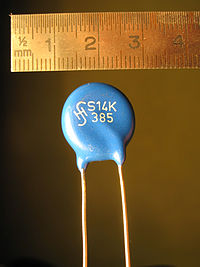
Photo from wikipedia
Abstract Lipophilic photosensitizers able to photo-induce lipid oxidation in biomembranes are, in general, much more efficient than hydrophilic ones; acting through the formation of singlet oxygen (1O2), which oxidizes the… Click to show full abstract
Abstract Lipophilic photosensitizers able to photo-induce lipid oxidation in biomembranes are, in general, much more efficient than hydrophilic ones; acting through the formation of singlet oxygen (1O2), which oxidizes the fatty acid double bonds (type II mechanism). Here we investigate the binding and photosensitizing properties of 4-(decyloxy)pteridin-2-amine (O-decyl-Ptr) using unilamellar vesicles of 1,2-dioleoyl-sn-glycero-3-phosphocholine (DOPC), a phospholipid with monounsaturated fatty acids. By means of molecular dynamic (MD) simulations, we showed that O-decyl-Ptr binds to the membrane in a localization that favors the direct reaction of the triplet excited state of O-decyl-Ptr with DOPC double bonds. As a consequence, although 1O2 is formed, O-decyl-Ptr acts mainly as a contact-dependent photosensitizer, meaning through radical formation (type I mechanism). Mass spectrometry analysis of vesicles irradiated in the presence of O-decyl-Ptr, demonstrated the generation of alcohols (LOH), ketones (LO) and hydroperoxides (LOOH). In agreement with the mechanistic hypothesis proposed, LOH and LO (type I photooxidation products) are formed faster than LOOH (type II photooxidation product). Interestingly, no short-chain oxidized products were detected. Accordingly, membrane fluctuations and formation of filaments and buds are observed during in-situ photo-activation of O-decyl-Ptr in giant unilamellar vesicles due to changes in membrane spontaneous curvature. Finally, we evaluated the effect of the photochemical processes studied at a cellular level and demonstrated in experiments of viability of mammalian cells that O-decyl-Ptr has important photodynamic properties. Similar experiments performed using the hydrophilic photosenstizer pterin (Ptr) show that alkylation leads to a striking increase in the efficiency of photosensitized lipid oxidation.
Journal Title: Dyes and Pigments
Year Published: 2021
Link to full text (if available)
Share on Social Media: Sign Up to like & get
recommendations!